Bondi offers the residents of Sydney something rare in a major city - a clean, beautiful ocean beach, a short bus ride from the city centre.
Easy access brings big crowds on sweltering summer days. For many Sydneysiders, the crowds and the tourist hype push Bondi down their list of preferred places for an ocean dip. Sydney is spoiled for fabulous beaches.
Bondi dwellers thrive on a vibrant local scene that is topped up by visitors. It's an especially popular spot with backpackers and beautiful young travellers.
Bondi's retained a low-rise charm despite a complete shift from its working class roots to gentrification over the past half-century. There have been no high-rise hotel and apartment developments along the beachfront - yet.
SAFETY NOTE - SYDNEY'S BEACHES ARE DANGEROUS. ALWAYS EXERCISE CAUTION AND SWIM IN PATROLLED AREAS BETWEEN FLAGS.
To avoid the crowds, come late or early - avoid the middle of the day on summer weekends and during summer school holidays.
I tend to time my Bondi visits late in the afternoon and I'm usually surprised by how much the crowds have thinned by then. During summer there is light until 8PM so arriving at 4.30 will give you plenty of time. You'll miss the crowds and you'll experience spectacular late afternoon light at the beach. Stay around for dinner.

Photo: Mark Bowyer Bondi Beach - can still be good for a dip in cooler months, Sydney
Patrolled swimming between flags at Bondi is usually in two areas - one right in front of the Bondi Pavilion and another at North Bondi. Both are great for swimming when conditions are right. North Bondi feels a little safer and better for families. There's an enclosed pool at North Bondi that's perfect for kids and anyone not confident in the ocean.
Beware of Bondi on dangerous days, rips can be treacherous - especially at the southern end where the "backpacker express" rip, named after its most common victims, causes many rescues and has taken a number of lives.

Rule 1 of the beach - stay between the flags
For open water swimmers, the swim across the bay at Bondi is superb. It's around 750 metres (each way) and feels pretty safe most of the time. Head just beyond the waves and surfers. You'll be amazed by the sea life amidst the rocks and weed at North Bondi.
Bondi is home to another Sydney legend - the Bondi Icebergs ocean pool. Icebergs is Australia's most photographed ocean pool. It's a sensational spot for laps and there's a kids pool too if you're there with the family.
Icebergs is located at the southern end of the Bondi Beach. Swimmers pay an admission fee. It's closed for cleaning on Thursdays.

Photo: Mark Bowyer Bondi Icebergs pool - Bondi Beach, Sydney
Bondi is a magnet for more than swimmers. Tanned and taut beauties flock to the promenade to parade their impressive physical accomplishments. The outdoor gym at North Bondi is a living museum of muscle-bound, tightly sculptured humanity in full performance mode.
In a good swell, the elevated lookout at the south end of the beach on the way to Icebergs is fantastic for watching and photographing surfers.
There's a lively scene off the sand at Bondi too. There are some excellent cafes, restaurants, bars and pubs.
There are also great walks to the south to Bronte and Coogee for the energetic.
The coastal walks open up other Sydney beach options like Bronte, Coogee and Clovelly.
Bondi has long had ties to Sydney's cultural life across music, film, art and literature. They remain though may be fading a tad as the bohemian crowd is priced out of the area.

Photo: Mark Bowyer Bondi Beach's legendary Life Guard base.
Getting to Bondi Beach
Bondi is around 9kms from the centre of Sydney and easily reached from downtown. Regular buses operate right to the beach. You can also take a train to Bondi Junction and a connecting bus to the beach - the walk from Bondi Junction station to the beach is around 30 minutes. On the hottest summer weekends, buses can be very crowded. There is quite a bit of paid parking available at Bondi though this is usually pretty tight on hot summer weekends. Best not to drive at busy times.
Rideshare services are an easy option for getting to Bondi.
Bondi History
Bondi is an Indigenous word that means "water crashing over rocks". The name is one of the few reminders of the original inhabitants of this part of Sydney's coastline.
Few of the millions who visit Bondi each year check out the Indigenous carvings located on Ben Buckler Point a few hundred metres from the main beach. Some of the carvings have been lost in the development of the area, a handful remain. To see the rock carvings, head to the old sewage tower at North Bondi near the North Bondi Golf and Diggers Club. The carvings are about 50m south east of the old tower.

Photo: Mark Bowyer Stone carvings on the Ben Buckler headland

Photo: Mark Bowyer Fish carved in stone on Ben Buckler headland, Bondi
The lack of signage and general regard for these precious engravings may come as a surprise to international visitors to Sydney. The lack of effort to protect and respect the engravings reflects poorly on Sydney and the local council.
An excellent opportunity to use this site as a place of reverence and learning about Indigenous culture prior to colonisation is being squandered here. The carvings are likely to be thousands of years old though the exact age is unknown.
The carvings were "regrooved" by Waverley Council in the 1960s.
There have been many improvements in recognition of First Nations people and culture in recent decades. This site indicates there's still a long way to go.
Bondi's post-colonisation fame as a beach dates back to the late 1800s when crowds flocked to a private estate to enjoy the strip. In the 1880s the beach was acquired by Waverley Council and by 1884 a tram service brought beachgoers from across Sydney, right to the sand. Access to Bondi in 2022 is a little more cumbersome but the beach is still easily reached by public transport and car.
In the twentieth century, Bondi was the place where Sydney beach culture evolved. The Bondi Surf Bathers’ Life Saving Club kicked off in 1907 and claims to be the oldest surf lifesaving club in the world - other clubs make the same claim. Manly makes similar claims and they seem better supported.
In the early decades of the twentieth century, Sydneysiders grew more confident with swimming in the ocean. By the 1920s, tens of thousands of people would take to the water on summer days.
These were golden years for Bondi and an inter-war construction boom saw the creation many art deco buildings - quite a number of which are still standing. Bondi is home to one of the best remaining collections of art deco architecture in Sydney.

Photo: Mark Bowyer Art Deco architecture of Bondi

Photo: Mark Bowyer Bondi's art deco architecture faces a battle against a preference for large windows and balconies.
For all their design flair, the art deco architects of Bondi didn't foresee the future popularity of large beach-facing windows and balconies. That failure and a rush to the new has seen many of Bondi's deco delights demolished in recent decades.
Bondi's deco boom preceded another change to the beachside suburb. It was the chosen suburb by a large number of post World War II immigrants to Sydney - many of them Jews escaping post-war Europe. Bondi's residents became a mix of white working class and immigrants, creating a distinctive new character in the beach suburb.
In 1938, Bondi's growing confidence on the beach was shaken when five people drowned and over 250 people were rescued after huge freak waves swept hundreds from the beach into the sea, on what became known as "Black Sunday".
Bondi was at the forefront of changing attitudes to swimwear - with some bathers pushing the bounds of rigid decency regulations. By the 1950s, women were being harassed on the beach by officials for their swimwear. Some were arrested. It wasn't until 1961 that the so-called Bikini Wars ended and costume regulations were relaxed.
As Sydney's population grew, the sewage outlet at Ben Buckler Point became an increasing hazard to swimmers and surfers. Bondi's reputation was harmed. Things were especially bad after heavy rains when effuent and other waste would wash up onto the beach.
By the 1990s new deep ocean outfalls pumped the sewage 3km out to sea. These days, Bondi's sea water is reliably clean.

Photo: Mark Bowyer Protected from rough surf at Bondi Icebergs, Bondi Beach

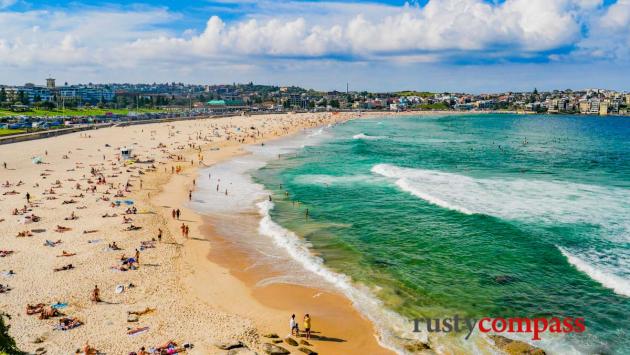
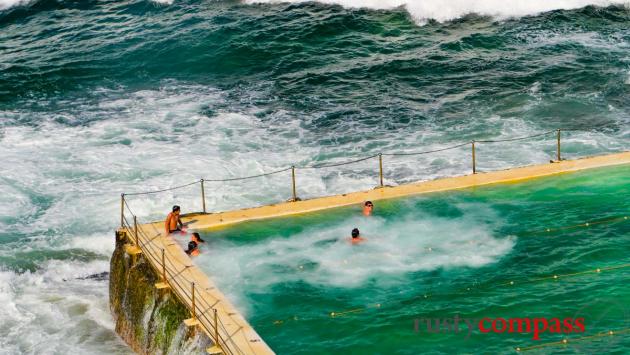
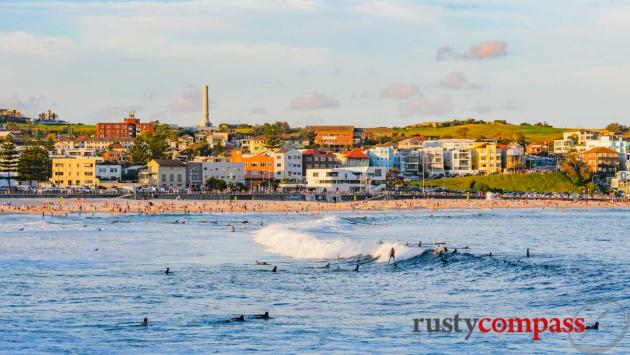
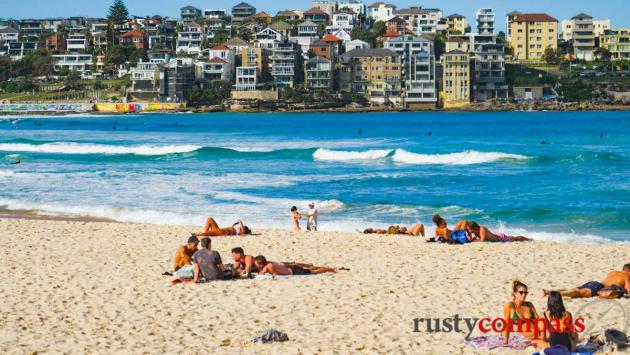
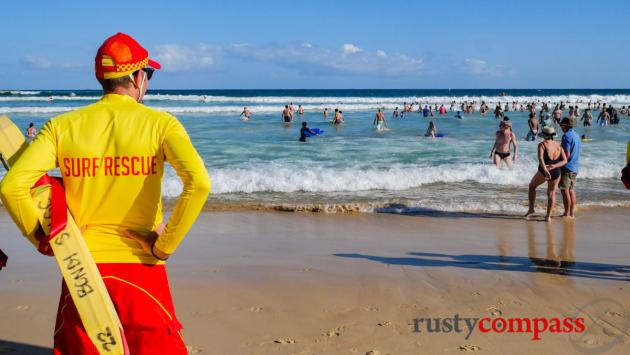
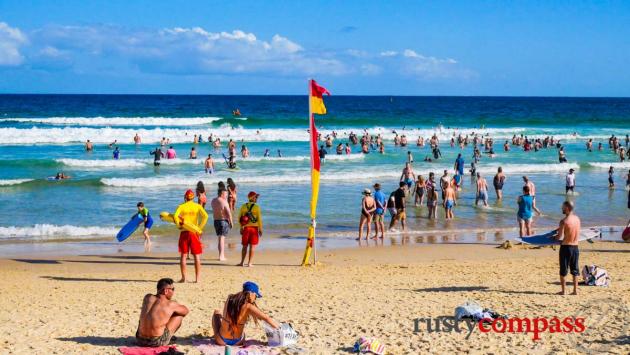





There are no comments yet.